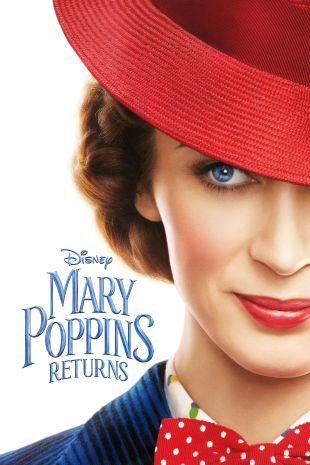
It's a jolly holiday with Mary again. At least, that's what Mary Poppins Returns is trying to go for. The movie strives for the original film's magical qualities, but falls short in ways that are hard to overlook.
In the 1964 film Mary Poppins-based on the book by P.L. Travers-Julie Andrews sang and danced her way into children's hearts as the magical nanny. Andrews portrayed the super caretaker rather well. With an authoritative parenting style, she was as firm as an army general, yet gentle and kind with the Banks children.

Now, the children are grown adults. Michael (Ben Whishaw) has a family of his own who he's raising in his childhood home at 17 Cherry Tree Lane. His sister Jane (Emily Mortimer), on the other hand, is still single. Michael has suffered the loss of his wife. Along with the financial strain of The Great Slump in the 1930s, he and his three children are in desperate need of saving.
Enter Mary Poppins. Played by Emily Blunt this time around, the fantastic nanny returns to lend a much-needed helping hand to the Banks family. But there's something that isn't quite right about Mary Poppins this time around. Blunt makes an admirable attempt to recapture and evoke Andrews' remarkable performance-gigantic shoes to fill, to be sure. But perhaps through poor direction, she doesn't quite capture the character as effectively. Part of Mary Poppins' character is her sharp tongue and stern demeanor, and Blunt conveys this well enough. However, it's the kindness that belies Poppins' almost noble mien that's missing. In Andrews performance, there's a kindly look that lingers on her face even as her prim and precise commands and gestures bring the world and the children into efficient order. It's hard to say where the subtle warmth is missing in Blunt's performance: perhaps she didn't smile enough, or perhaps it was an errant gesture in the eyebrow that indicated impatience rather than disappointment. Either way, the Mary Poppins that returns to the Banks has a slightly mean edge to her.

The central attraction of the original film is song and dance though. Among some of the more memorable sequences in the original are Spoonful of Sugar, Jolly Holiday, and Chim Chim Cher-ee. And who can forget when Mary Poppins, high above the streets of London, marched up a set of stairs made of black chimney smoke?
Here in the sequel, there are far fewer memorable moments or catchy tunes. At times, songs are quietly woven into the narrative with neither ceremony nor dance-a questionable decision. The film is at its finest when it returns to the spectacle that made the original so delightful. Through a combination of song, music, and dance, the movie manages to transport viewers into its storybook world. And it certainly is a treat when the filmmakers make the effort. It's wonderful to see a return to the old-fashioned mixture of live-action film and hand-drawn animation, which viewers are treated to when Mary Poppins and company travel to the Royal Doulton Music Hall.
But the enchanted quality of the journey is ruined once it transitions into Mary Poppins' stage performance. It's utterly inexplicable to see her transform from a proper British nanny into a sassy burlesque dancer. This tonal dissonance might be explained by the fact that it's a nightmare (and it's a nightmare indeed), but the film could've easily done without it. Rounding out the failures is the climatic Big Ben scene. Somehow, the movie manages to take the magic out of turning back time, turning what could've be an imaginative moment into an engineering exercise in nuts and bolts.
Ultimately, Mary Poppins Returns takes its dandy time returning to the child-like wonderment and joy of its predecessor. Only late into the movie does Blunt begin to approach Andrews' performance; and similarly, it's mostly in the film's closing moments in the park where viewers are treated to a wonderfully colorful, bubbly storybook feeling of delight. Given all the time that the movie asks of its viewers, it's hard to recommend the movie when moviegoers can just watch the original.
